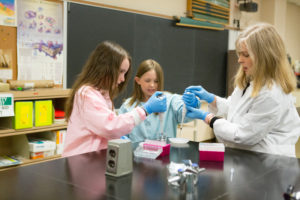Thank you April Johnston and Penn State Beaver for the fantastic web article of our recent fellows visit to your campus. Reprinted from http://beaver.psu.edu/story/3010/2018/04/06/beaver-biology-professor-star-book-published-local-fifth-graders

Image: Cathy Benscoter Beaver biology professor is the star of a book published by local fifth-graders
April 6, 2018
MONACA, Pa. — Imagine this is our future: The insect population explodes. The Zika and West Nile viruses infect billions. Crops die. The rainforest disappears.
That’s not the plot of a dystopian novel. That’s life without bats.
And that scares Kaitlyn Desrochers, a fifth-grader at Baden Academy whose affection for bats began three summers ago when she visited Mammoth Cave National Park and learned about the animal’s rapid decline. So she decided to do something about it.
Desrochers and fellow fifth-grader Kennedi Emery began working in Baden Academy’s media lab to write a book about bats. They’re hoping that once their fellow students know all the ways in which bats help the world, they’ll take up the fight to help save them.
“I don’t know why, but I just really love bats,” Desrochers said.
Although she loves them, she didn’t know enough about the science to complete the book.
So Desrochers and Emery turned to one of Pennsylvania’s leading bat experts for help: Penn State Beaver Associate Professor of Biology Cassandra Miller-Butterworth.
To the fifth-graders, Miller-Butterworth is a kind of superhero. She’s been studying the plight of little brown bats for years, and her work has helped in the understanding of white nose syndrome, the disease that’s killing off the winged creatures at a frightening pace. In the span of just 12 years, white nose syndrome has spread to 29 states in the U.S. and five provinces in Canada.
It’s facts like these that have made Miller-Butterworth’s help on the book invaluable, according to Ellen Cavanaugh. Cavanaugh is the CEO of Grow a Generation, which places research fellows in Baden Academy classrooms to assist students with special projects. She also runs the media lab, so she’s watched as Desrochers and Emery have interviewed Miller-Butterworth, penned passages, sent drafts off to the professor for editing, and then made the necessary changes.
The plot goes something like this: A little brown bat named Kennedi (yes, named after one of the authors) wakes from her hibernation to find that thousands of her bat friends died over the winter. In an effort to save her remaining friends, Kennedi visits Miller-Butterworth’s lab, where she learns strategies to halt the spread of white nose syndrome.
“Plant bat friendly gardens, build a bat house and spread the word,” Miller-Butterworth says. “Love bats. Don’t be afraid of them. You’re more likely to be struck by lightning than to contract rabies from a bat.”
The book is also stuffed with fun bat facts: Bats eat their weight in insects every night. Bats are responsible for more than 90 percent of the regeneration of rain forests. Bats save farmers in the United States more than $23 billion a year in pesticides.
The book should be ready for publication in August and will be available on the Amazon and Barnes and Noble websites, with all proceeds going to bat conservation. Desrochers and Emery also will make an appearance at the Beaver County Book Fair to do a few book signings.
But first, they get to tell their fellow students all about their experience working with Miller-Butterworth, including the morning in March when they visited her lab, donned white lab coats and got to see bat DNA.
“Bat DNA!” Cavanaugh said to the fifth-graders. “Do you have any idea how cool that is?”
Based on the wide smiles planted on Desrochers and Emery’s faces, it was very, very cool.



